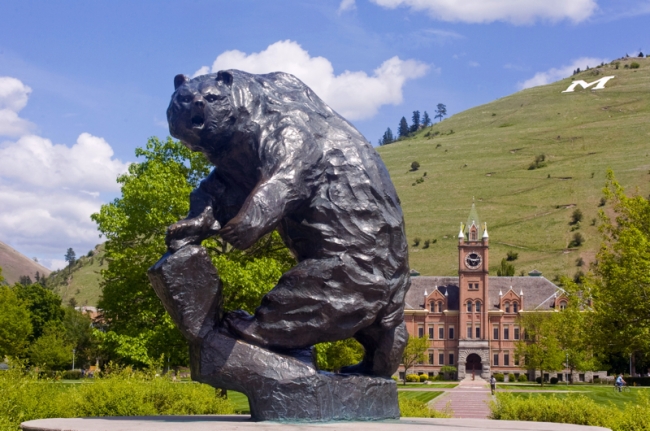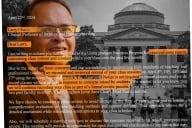You have /5 articles left.
Sign up for a free account or log in.

The Montana Grizzlies are adapting to being the national "blueprint" for campus sexual assault.
University of Montana
One little word made the University of Montana’s settlement agreement with the federal government different from all the others.
“Blueprint.”
With that, the U.S. Departments of Justice and Education made Montana the model institution for responding to sexual harassment and assault, an issue that’s receiving more public and federal scrutiny than ever. It thrust Montana officials even further into the public spotlight than they already were, following a string of sexual assault reports, the most high-profile of which involved football players and accusations that administrators were sweeping the issue under the rug.
And in trying to comply with what some say is the most extensive settlement agreement ever put forth by the Education Department’s Office for Civil Rights under Title IX of the Education Amendments of 1972, which prohibits sex discrimination on campuses, Montana is also caught up in claims by civil liberties advocates that the guidelines it’s been told to codify are overreaching and even violate the First Amendment.
But with the new academic year under way, the changes on campus are coming to fruition. And whether the university is ready for it or not, other colleges are looking to the designated blueprint as guidance for their own campuses.
It’s a position Montana officials say they’ve embraced, even as they hint – with varying degrees of subtlety – that they neither asked nor expected to be put in this unusual position.
“'Blueprint’ is not really our designation and I hesitate to be put in that situation when what we are trying to do is just tend to our own situation,” Montana President Royce C. Engstrom said in an interview. “If other campuses around the country can benefit from our actions and our strategies, then that’s great. But each campus does have its own situation.”
But the "blueprint" designation, and the national scrutiny that came with it, has at times been tough on the campus, said Christine Fiore, a Montana psychology professor who advises Engstrom on addressing sexual violence.
“I think the students have been angry – they feel like they are suffering the consequences of a few people who are bad actors,” she said. There’s also been a good deal of frustration among the staff members who have worked on Title IX and sexual violence issues for years, who don’t deny there’s still work to be done but want to acknowledge what’s already changed, too. “I think sometimes the university has been tired of negative publicity.”
One official flat-out declined to talk about the blueprint status, saying it wouldn’t be appropriate as that’s the federal government’s designation.
Policy Grounded in History
For years, Montana has been dealing with the fallout from a very public string of incidents. When DOJ announced its investigation of the university and the city in May 2012, it noted at least 11 reports of sexual assaults involving university students over an 18-month period, and 80 rapes in Missoula over three years. At least three cases involved university football players, and the anger over those alleged incidents and accusations of cover-ups was palpable. (One administrator, for example, inquired as to whether a student who spoke publicly about her case could be punished under the Student Code of Conduct. Another asked why one incident was referred to as "gang rape.")
Montana officials knew they had a problem before the feds came knocking. In winter of the 2011-12 academic year, after two students separately said they were drugged and gang raped, the university hired former state Supreme Court Justice Diane Barz to review sexual assault cases on campus. Barz uncovered nine more cases and argued that the investigation should continue.
One of the first major steps Montana took was controversial in itself. About a year ago, officials began requiring all students to take the computer tutorial Personal Empowerment Through Self Awareness, or PETSA. Now in its second generation, PETSA includes more student voices and aims to show that even if you’ve never been assaulted, odds are you know or will know someone who has. But the mandatory nature of the program, and its sensitive content, continue to draw the ire of some students.
Fiore has more or less accepted that (based on feedback) 6 percent of students appear determined to ignore the tutorial’s contents, which covers the nuances of state law, campus policy and social issues. But she believes the “incredibly positive” response from everyone else – more than three in four students actually thank her for the program – is evidence that it’s working.
“There’s not a student who has gone through this who doesn’t know the issues that have been in the newspaper,” Fiore said. “Knowing about sexual violence is mandatory as a member of the college community.”
Vanderbilt University has launched its own PETSA tutorial, and Montana is consulting a few dozen other campuses on that program and the campus climate survey, which questions students on attitudes, procedures and experiences. (The settlement requires an annual survey through 2015-16, but Fiore wants to keep it going every two or three years after that.)
“I think the level of scrutiny is challenging, but it’s also helpful,” Fiore said. “The university as a whole, and everybody we work with, they’re really enthusiastic – they want to take care of this.”
Questions of Overreach
When Legal Counsel Lucy France explains Montana’s progress, she talks a lot about “balance.” Balance between protecting victims and the First Amendment. Balance between DOJ oversight and faculty rights. Balance between a national model and what’s right for the campus.
After back-and-forth draft exchanges pushed approval of the policy months past the deadline for federal approval, DOJ gave the go-ahead, but Montana officials are not totally happy with the final product. They’re trying to negotiate a particularly controversial point in the settlement agreement that requires the university to report to the Justice Department the names of any faculty members who don’t undergo a mandatory discrimination prevention tutorial, designed to teach instructors the new regulations so they can help students who want to report. Faculty members have asked Engstrom why their names should be reported.
And while France said she believes the new policy, which takes much previous case law into account, complies with the First Amendment, lawyers are “still looking at that.” Critics have questioned Montana’s policy because (at OCR’s behest) it defines sexual harassment as “any unwelcome conduct of a sexual nature,” including speech. Unlike past versions – and counter to what groups including the Foundation for Individual Rights in Education advocate – it does not require an action to be “objectively offensive” to be deemed harassment.
U.S. Sen. John McCain asked DOJ why and how it could have "single-handedly redefined the meaning of sexual harassment at all universities and colleges across the country that receive public funding," and university faculty have protested the reporting of names. But any policy changes in the next three years must get DOJ approval.
“I think they’ll listen to concerns, but again, it’s achieving that balance,” France said.
OCR, for its part, has denied that its rules amount to “speech, conduct or harassment codes” violating the Constitution.
“In preventing and redressing discrimination, schools must formulate, interpret, and apply their rules in a manner that respects the legal rights of students and faculty, including the First Amendment,” OCR wrote in a letter to critics in May.
Title IX coordinator Eric Gutierrez said procedural changes to streamline reporting have already resulted in more complaints reaching his desk (and those of his two staff investigators).
“I would say my docket is fuller,” Gutierrez, who is also director of equal opportunity and affirmative action, said during a break from his second week of DOJ training. He declined to comment on the nature of the complaints, but France posited that -- if complaints have indeed increased -- procedural changes and publicity for them probably prompted more filings. (Among advocates, more reporting is generally considered a good thing because it's linked to greater awareness, not higher incident rates.) Additionally, whereas discrimination and harassment complaints used to go through the dean of students' office, the new policy sends them to Gutierrez.
"One of the objectives is to make sure students know where to report," France said. "That doesn't mean everything rises to the level of, there will be an investigation."
Lots of smaller shifts are materializing into two big-picture changes on the Montana campus: more streamlined policies and regular communication between departments (for example, public safety and the Student Advocacy Resource Center), and broader awareness among all individuals of what sexual violence is and how it should be addressed.
Whether the policy will result in stifling free speech is yet to be determined. But it has certainly generated conversation.
“It’s an ongoing dialogue – the topic of sexual assault, sexual harassment,” Engstrom said. “It’s almost impossible to avoid.”
Inspiring Change
The blueprint declaration has not gone unheard, especially throughout the state.
Montana officials have participated in conference calls this summer with other campuses looking for materials and information, and they spoke to staff from other Montana University System institutions in person at a conference in Bozeman, said Elizabeth Hubble, co-director of the women's and gender studies program and chair of the University Council on Student Assault.
The interest from other universities signals a desire to avoid a similar federal investigation, Hubble said, but more than that it’s “buy-in” from institutions acknowledging that more than compliance is at stake. What they really want is a cultural change.
“I take it as a positive challenge,” she said. “My belief is that we are starting to see a shift.”
At Montana, for example, more male students are volunteering with the resource center. A new campus relations public safety officer holds office hours in the residence halls to be a more effective student-cop liaison. Departments and committees and administrators that didn’t used to talk to each other now do. Athletes who have felt unfairly targeted by bad press are helping out with awareness projects. And students, staff and faculty are learning how to handle allegations and ensure each and every one makes it to Gutierrez.
Campus police have gone through their own training, in part to learn how to follow the new sexual assault policy and procedures. (The campus used to have one policy for all forms of assault; it's split in two now.) They've been told to focus on care for the victim, by asking only questions that are appropriate -- rather than, say, what the woman was wearing -- and informing students about all the available resources. The procedures are better defined, for everyone from the first responder to the suspect interviewers. (In an alleged rape, campus safety is first on the scene but then the case is handed over to Missoula police.)
Police Captain Ben Gladwin spoke highly of the training, and would "highly recommend" a similar review for other campuses. (A private consultant and DOJ liaison conducted the training.) But he acknowledged the process have been tough on his staff.
"It was largely perceived that perhaps my officers were incapable of handling this type of thing, and I think that really affected morale," Gladwin said. "That being said, obviously there's always room for improvement."
Administrators and faculty know they’re still far from the finish line – if there even is a finish line. But for now, the slow and steady march continues.
“It’s been challenging – I don’t wish it on anybody,” Fiore said. “But I think we’ve grown and learned something.”








